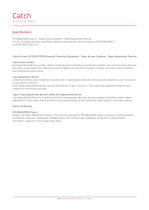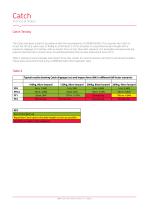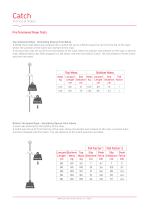
Catalog excerpts

Catch - CTC 100 Product Info Sheet Rope Adjustment Device Conforms to EN 12841:2006 A Hot forged aluminium body Large attachment eye for multiple connections Rope friendly stainless steel cam Tether attachment point (2mm diameter cord) for drop-free installation and removal Screw-lockable side plates for semi-permanent attachment to safety line Towable Release Mechanism (Patent Pending) replaceable part no. CTC 100 TM Side plate locking screw stowage point in boss Stainless steel boss The Catch Injection moulded/ hot forged handle ergonomically shaped for ease of use with descent devices Rope adjustment device which moves freely up the rope, can be towed down the rope using the Towable Release Mechanism and locks under static or dynamic loading. The Catch features a non-aggressive, rope friendly stainless steel cam. This is spring loaded allowing the Catch to be positioned above the user. DMM Catch Info Sheet Version 2.2 - Page 1
Open the catalog to page 1
How does it work? The Catch incorporates a unique Towable Release Mechanism (TRM). The TRM allows the user to tow the Catch whilst descending yet will enable it to lock onto the safety line in the event of a main line failure. The TRM has a panic function that will initiate the locking of the Catch onto the safety line. The Catch will also lock onto the safety line if the user simply lets go of the TRM. The Catch has undergone extensive field testing, including real person main line failures and uncontrolled descents. 1. User lets go of the TRM in a fall. This causes the Catch to lock onto...
Open the catalog to page 2
Specifications at a glance > Certification - Conforms to relevant EN Standards. > Rating - Based on manufacturer’s extensive testing. Certification EN 12841:2006 Type A - Safety Line Rope Adjustment The Catch is certified to EN 12841:2006 for Type A devices on approved 11mm diameter kernmantel ropes at a rated load of 100 kg, (single person use) under hot, cold and wet conditions as defined in the standard. See Table 1, Page 5 for list of approved ropes and Table 2, Page 6 for heavier user information. Rating 200kg two person rescue load. See Table 2, Page 6 for detailed information on fall...
Open the catalog to page 3
Technical Notes Specifications EN 12841:2006 Type A – Rope Access Systems – Rope Adjustment Device For use on approved 11mm and 7/16in diameter kernmantel ropes complying to EN 1891:1998 A or NFPA 1983 (2012 ED.) Extract from EN 12841:2006 Personal Protecion Equipment - Rope Access Systems - Rope Adjustment Devices rope access system personal fall protection system, which comprises two separately secured sub-systems, one as the working line and the other as the safety line, which are used for getting to and from the place of work, and which can be used for work positioning and rescue. rope...
Open the catalog to page 4
Technical Notes Approved Ropes EN 12841:2006 Type A The DMM Catch - The Safety Line Rope Adjustment Device tested fully complies with the requirements of the standard EN 12841:2006 Type A devices on 11mm diameter EN 1891:1998 A ropes or on 7/16in diameter NFPA 1983 (2012 ED) ropes as listed in the table below and at a rated load of 100kg under hot, cold and wet conditions as defined in the standard. NB - The Catch must ONLY be used on ropes tested and approved by DMM. Access Unicore BLUE WATER BLUE WATER BLUE WATER Worksafe Plus Performance Static Performance Static Patron Plus DMM Catch...
Open the catalog to page 5
Technical Notes Catch Testing The Catch has been tested in accordance with the requirements of EN12841:2006. This requires the Catch to arrest the fall of a steel mass of 100kg in a Fall Factor 2 (FF2) situation on a specified lanyard length with a maximum slippage of 2 metres, with an impact force .of less than 6kN. However it is advisable and good working practice that the Catch should never be positioned below the harness attachment point (FF1). Table 2 displays typical slippage and impact force test results for various masses, fall factors and lanyard lengths. These tests were performed...
Open the catalog to page 6
Technical Notes Pre-Tensioned Rope Tests Top Tensioned Rope - Simulating Rescue from Below A 100kg mass (Top Mass) was lowered onto a Catch set up on a 80cm lanyard at 1m from the top of the rope, where the position of the Catch was marked on the rope. A second Catch was set up 2m from the bottom of the rope, where its position was marked on the rope. A second mass (Bottom Mass) was then dropped in a fall factor one onto the bottom Catch. The slip distance of each Catch was then recorded. Bottom Mass Mass Lanyard Slip Mass Lanyard Slip Fall kg Length Distance kg Length Distance Factor cm cm...
Open the catalog to page 7
Technical Notes Sloping Roof The Catch should be positioned high and to one side of the user ensuring that nothing will affect the proper function of the Catch. Do not work in a position where the Catch may become trapped between sloping surfaces and the user (or anything else) as it may not function properly. Pendulum Pendulum falls should be avoided wherever possible. Simulated Pendulum Test A 100kg mass was suspended horizontally approximately 3m from the anchor point. The Catch was connected to the rope at distance 3m from the top of the rope, where the position of the Catch was marked...
Open the catalog to page 8All DMM Professional catalogs and technical brochures
-
DMM PROFESSIONAL WORKBOOK 2018
43 Pages
-
DMM Professional Catalogue
76 Pages
-
treecare prodUcts
20 Pages
Archived catalogs
-
Buyers Guide
71 Pages
-
RPM Shackle
3 Pages
-
Edgehog
2 Pages







